CASTNET Special Studies
Research and special studies are conducted to strengthen our understanding of dry deposition processes, improve model inputs, and test new monitoring methods. Click on the links below to read about on-going research at CASTNET sites.
- Reduced Nitrogen at IMPROVE and CSN Sites
- MARGA Field Performance Evaluation
- CASTNET Ammonia Special Study (ACCS)
- Ameriflux Deposition Study
Reduced Nitrogen at IMPROVE and CSN Sites
Update: January 2021
Total reduced nitrogen (NHx) measurements are not routinely performed in the US and currently no regulatory requirements exist to measure NHx. However, scientific and policy interest in the increasing trend in NHx concentrations in many regions of the US has evolved since NHx can lead to atmospheric fine particulate matter (PM2.5) formation and visibility impairment and, once deposited, can cause eutrophication, loss of species biodiversity and algal blooms. This study, set in the southeastern US, was designed to measure reduced nitrogen and to assess measurement methods for implementation in long-term monitoring networks, specifically the Interagency Monitoring of Protected Visual Environments (IMPROVE) and Chemical Speciation (CSN) networks. The IMPROVE network provides routine measurements of speciated particulate matter (PM) that support the regional haze rule and source apportionment analyses. The CSN provides data that support emission control strategies, health effects research, and model evaluation. Both networks collect a 24-hour integrated sample every 3 days.
The goal of this study was to determine whether acid-coated filters could be deployed at existing sites using existing network equipment to measure reduced nitrogen concentrations in hot, humid environments. Incorporating an NHx measurement into the CSN and IMPROVE networks would leverage existing infrastructure, reduce costs and provide national coverage. The addition of NHx also offers the potential for providing NHx and particulate ammonium (NH4+) estimates at sites co-located with the National Atmospheric Deposition Program’s (NADP) Ammonia Monitoring Network (AMoN). Hourly measurements are ideal for evaluation of chemical transport models (CTMs) and understanding atmospheric processes that vary diurnally. On the other hand, the use of speciation samplers for 24-hour NHx samples, collected every 3 days, is a cost-effective way to improve current understanding of the spatial and temporal variability of NHx and to generate data useful for source apportionment, potential for PM formation, and more general model evaluation. When co-located with AMoN, monthly, seasonal and annual averages of NH4+ can be generated which are of direct benefit to PM and oxides of nitrogen and sulfur (NOx/SOx) NAAQS reviews and subsequent implementation. Chen et al. (2014) performed a similar study in the Western and midwestern US using only the IMPROVE sampler. In that study the acid-impregnated filter data compared well with Annular Denuder Filter Pack System (ADFPS) (URG Corp) measurements.
MARGA Field Performance Evaluation
Update: August 2013
The Monitor for AeRosols and GAses (MARGA) 1S system was deployed at the Beltsville, MD, CASTNET site between January 2013 and June 2015. Five extended measurement campaigns have produced 17 months of hourly ambient concentration data for soluble gases (HNO3, HONO, SO2, and NH3) and particles (NO3-, SO42-, NH4+, Ca2+, Mg2+, K+, and Na+) including eight months of co-located measurements from two separate MARGA units.
The MARGA units performed well when compared with a co-located pulsed fluorescence SO2 analyzer with hourly SO2 gas concentrations having a median average relative percent difference (MARPD) of 35%. Performance statistics between the co-located MARGA units were excellent with MARPD values ≤15% for aerosol species (NH4+, NO3-, SO42-) and values ≤ 20% for gaseous species (HNO3, HONO, SO2). Ammonia was an exception to this (MARPD = 38%) as its polarity and solubility make it susceptible to inlet adsorption artifacts. To investigate this, one of the MARGA inlets was shortened from 115" to 33", which increased the overall recovery of NH3 by 2.6μg m-3 d-1 over a cold weather period. This phenomenon was not observed during the warmer weather and the MARPD values during this time were ~26% for NH3.
A MARGA 1S unit was deployed by Colorado State University in Theodore Roosevelt National Park and utilized during the FRAPPE air quality study. In addition to data collected during those intensives, that unit was co-located in a high NH3 concentration area (a lab in Fort Collins) with two hourly NH3 analyzers (Air Sentry and Picarro).
Recently, two of the three MARGA 1S units were converted into a single unit able to sample concentration gradients by placing inlets at two different heights. This unit is slated to be tested by both in the laboratory this fall and deployed at a coastal site near Charleston, SC, in the summer of 2016.
Update: April 2013
Ambient particulate and gaseous concentrations were sampled from the two MARGA units from November 2012 - February 2013. Data from this time period are currently being validated and analyzed. The slopes for regression between the two instruments is within ± 6% for particulate SO42-, NH4+, and gaseous SO2 and NH3, and ± 12% for particulate NO3-. The instruments are also currently being evaluated for accuracy with results from the weekly CASTNET filter pack, the bi-weekly AMoN passive NH3 sampler, and hourly SO2 and NOy. Improvements to the operational methods and protocols have been developed by CAMD during this initial phase of the field comparison. The two MARGA units received upgrades to parts and software components in January 2013. Measurements collected after the upgrade are still under evaluation. One of the two MARGA units was shipped to Colorado State University for inclusion in an intensive atmospheric chemistry sampling campaign to take place in Theodore Roosevelt National Park, ND, during the summer of 2013. A third unit, a new model was installed in April at the Beltsville site for precision and accuracy comparisons.
Update: April 2012
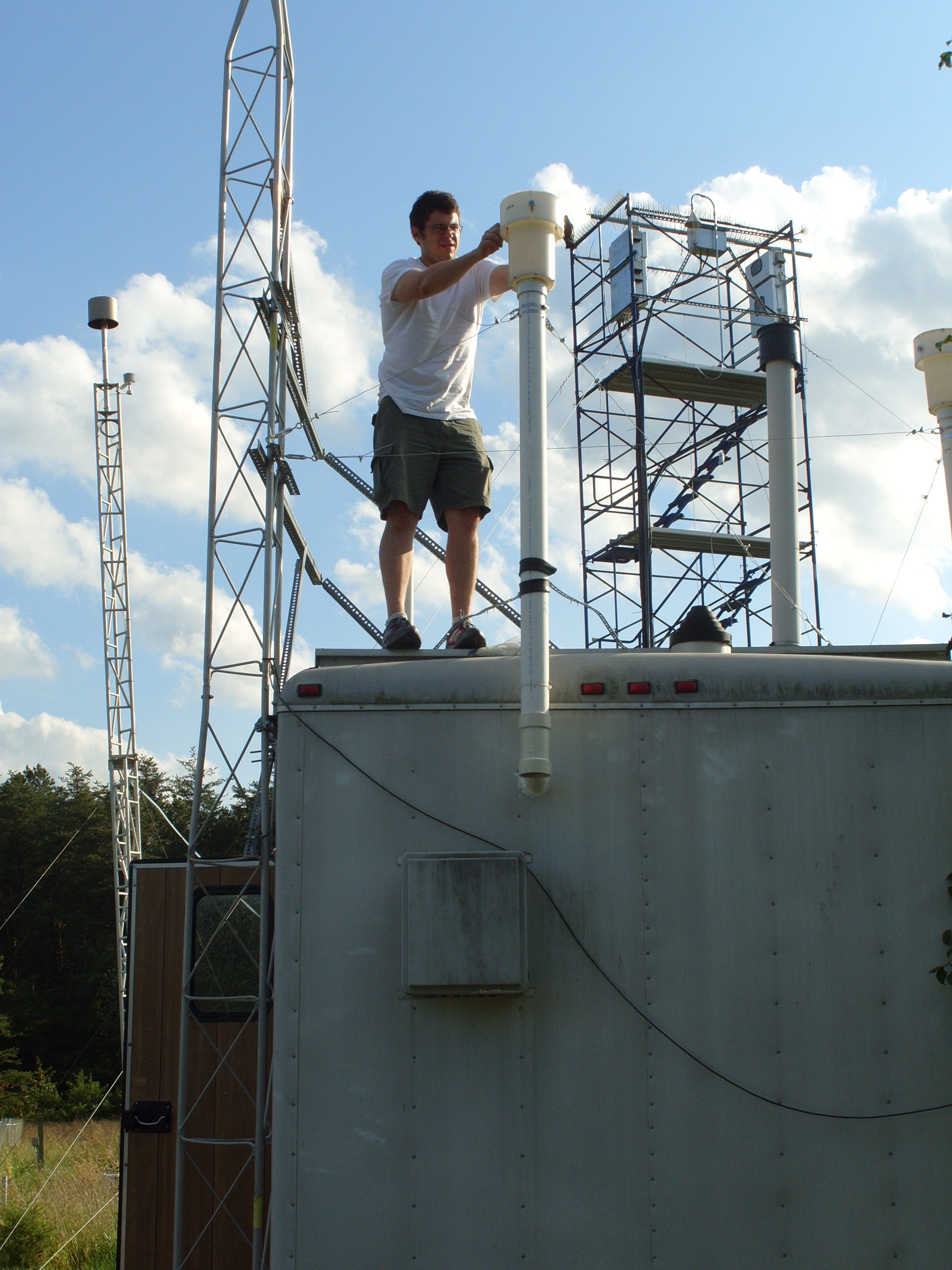
The two MARGA systems (MARGA-1 and MARGA-2) were installed at the BEL116 CASTNET site at the end of 2011 and have been undergoing maintenance and replacement of the analytical modules. As of April 1, MARGA-2 is collecting ambient concentration measurements and the results are being evaluated for consistency and stability. Additional parts are needed for MARGA-1, but it is expected to be operational by the end of April.
ORD continues to assess the applicability of the MARGA 2S, a direct flux measurement system, at the Duke Forest research site in NC.
Update: December 2011
Installation of the two MARGA systems at the BEL116, MD, site has been completed. Internet access was connected to the instrument laptops for real time, remote data access. A laboratory space was created at a nearby facility for preparing solutions and washing the glassware. Performance quality solutions have been prepared at the lab and transported to the site, where quality assurance tests using the manufacturer's recommended data quality objectives are currently in progress. The first step is to test the analytical response of the MARGAs with an internal standard solution and standards of ammonium sulfate ((NH4)2SO4), potassium chloride (KCl), and ammonium nitrate (NH4NO3) in concentrations assumed to bracket typically observed atmospheric concentration levels. The next steps will be for the MARGAs to undergo a field performance evaluation.
The objectives of the Field Performance Evaluation are:
- to re-establish the operational performance of the MARGAs observed in the ETV,
- to make improvements in the MARGA performance especially with regards to the quantification of ammonia (NH3) and ammonium (NH4+) and nitrate (NO3-) and nitric acid (HNO3),
- to better characterize the MARGA performance by evaluation with different reference methods including weekly CASTNET filterpack measurements and hourly trace-gas concentrations for SO2 and NOy,
- to characterize operational issues and time-demand associated with routine maintenance and troubleshooting in determining implementation of the MARGA in future monitoring efforts.
Current collaborators in this project include:
- U.S. EPA Office of Research and Development
- U.S. Department of Agriculture/Agricultural Research Service
Update: October 2011
The Monitor for AeRosols and GAses (MARGA) is a multi-pollutant semi-continuous instrument being
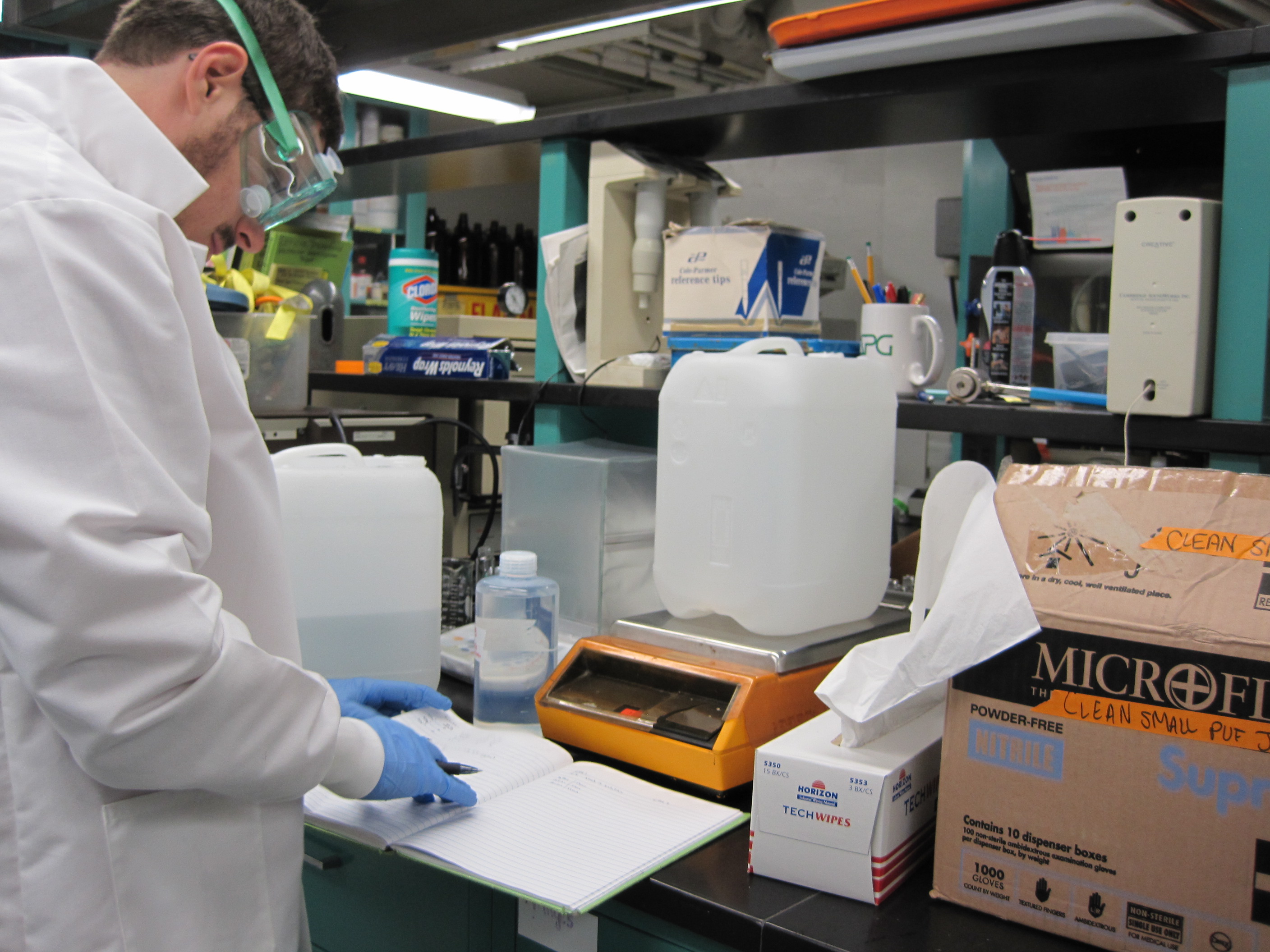
Installation of two MARGA systems at BEL116 is almost complete. The MARGA systems were moved to the site from EPA's ORD monitoring station in RTP, NC. The next steps for the MARGA include:
- calibrating the instruments using internal and external standards,
- setting up an Internet connection to get real-time measurements from the site,
- and comparing the MARGA results with the trace gas SO2 monitor and CASTNET filterpack measurements from the BEL116 site.
Updates on the MARGA study will continue to be provided on this site periodically.
Ammonia CASTNET CSN Study (ACCS)
Update: January 2015
The final results of the ACCS were published in Environmental Science in December 2014.
Update: March 2013
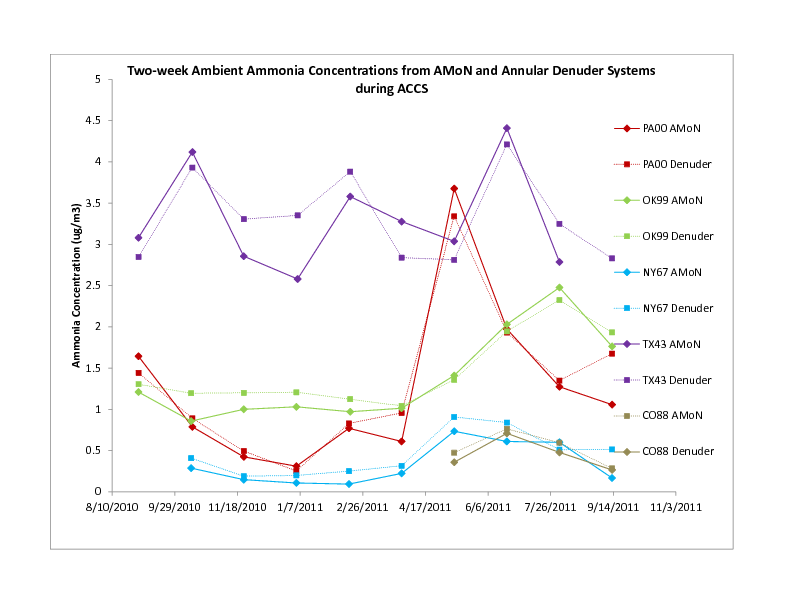
The ACCS began in August 2010 and the last sample was collected in October 2011. Final data, including ambient NH3 concentrations and laboratory and field blanks, have been submitted to EPA. Preliminary results from the AMoN Radiello samplers versus duplicate annular denuders (reference method) from the five sites are described below.
The mean absolute relative percent difference (MARPD) between the passive samplers and the annular denuders from the five sites was 20%. MARPDs between individual sites ranged from 11% (Palo Duro, TX) to 46% (Connecticut Hill, NY). The first figure below shows the bi-weekly NH3 concentrations as measured by AMoN and the average concentrations over the 2 one-week denuder sampling periods for each site. Concentrations ranged from less than 0.5 ug/m3 (Connecticut Hill, NY, and Rocky Mountain National Park, CO) to 4.5 ug/m3 (Palo Duro, TX). The second figure shows the 2-week average NH3 concentrations from AMoN versus the annular denuders for the 5 ACCS sites. There is good correlation (0.96) between the two sampling methods for the range of concentrations measured during the year sampling period.
The precision of the duplicate denuder systems at the five sites was 10%. Triplicate Radiello passive samplers were deployed at the five AMoN sites during the
ten ACCS sampling periods. The precision of the triplicate samplers was 12% and comparable to previous quality control studies performed by the NADP.Update: April 2012
Preliminary results from the ACCS were presented at the NADP Total Deposition Science Committee Meeting in Providence, RI (Oct. 2011). The preliminary results showed AMoN samplers compared well with the URG annular denuders, while the Super SASS mini-parallel plate denuders were likely biased low at CHE185 and ROM206.
In addition to the ammonia analysis, ion concentrations measured with the CASTNET filter pack were compared with those measured with the Super SASS ion canisters (routinely used in the Chemical Speciation Network). Preliminary results showed good agreement for gaseous SO2 between the filter pack and the ion canisters, but comparison for the particulates (NO3- and NH4+) showed the ion canisters were biased low when compared to the filter pack. We believe this bias may be attributable to the cut-point. The Super SASS uses a Teflon cyclone with a 2.5μm cut-point while the filter pack is an open-faced surface, which likely allows larger particles to collect on the filters.
Final results will be published in two journal articles, one providing the results from the ammonia study and the other showing the results from the ion comparison.
Update: November 2011

Ambient ammonia (NH3) concentrations are not routinely measured at CASTNET, Chemical Speciation Network (CSN) or NCore sites, which results in a significant gap in our understanding of the total nitrogen budget. In some areas, NH3 dry deposition is estimated to be approximately 30% of the total deposited nitrogen (e.g., Rocky Mountain NP). The Ammonia Monitoring Network (AMoN), a newly formed sub-network within the NADP, measures ambient NH3 concentrations at approximately 50 sites throughout the United States.
This study was developed to validate the passive Radiello samplers deployed in the AMoN, to characterize the sulfur and nitrogen species collected on the CASTNET filter pack and the ion canisters from the Super SASS (used in the CSN), and evaluate a newly developed mini-parallel plate denuder (MPPD) for measuring NH3 in one of the channels of the Super SASS. To accomplish these goals, a five-site study (site locations indicated on the map below) plan was developed. The first sampling period began in August 2010, and the study was completed in September 2011. To stay within budget, two-week sample deployments occurred every 6 weeks for a total of 10 sampling time periods. Each site was collocated with AMoN, which provided a two-week NH3 concentration. All AMoN samplers were prepared, shipped and analyzed by NADP’s Central Analytical Laboratory. AMoN data are processed and posted to the NADP AMoN website routinely. In addition to the passive samplers, each of the five sites also deployed two consecutive 1-week annular denuders systems (ADS) as the reference method. Three sites deployed two consecutive 1-week MPPDs housed within the Super SASS module and two consecutive 1-week ion canisters. The MPPDs are being tested for routine use in the CSN for capturing 24-
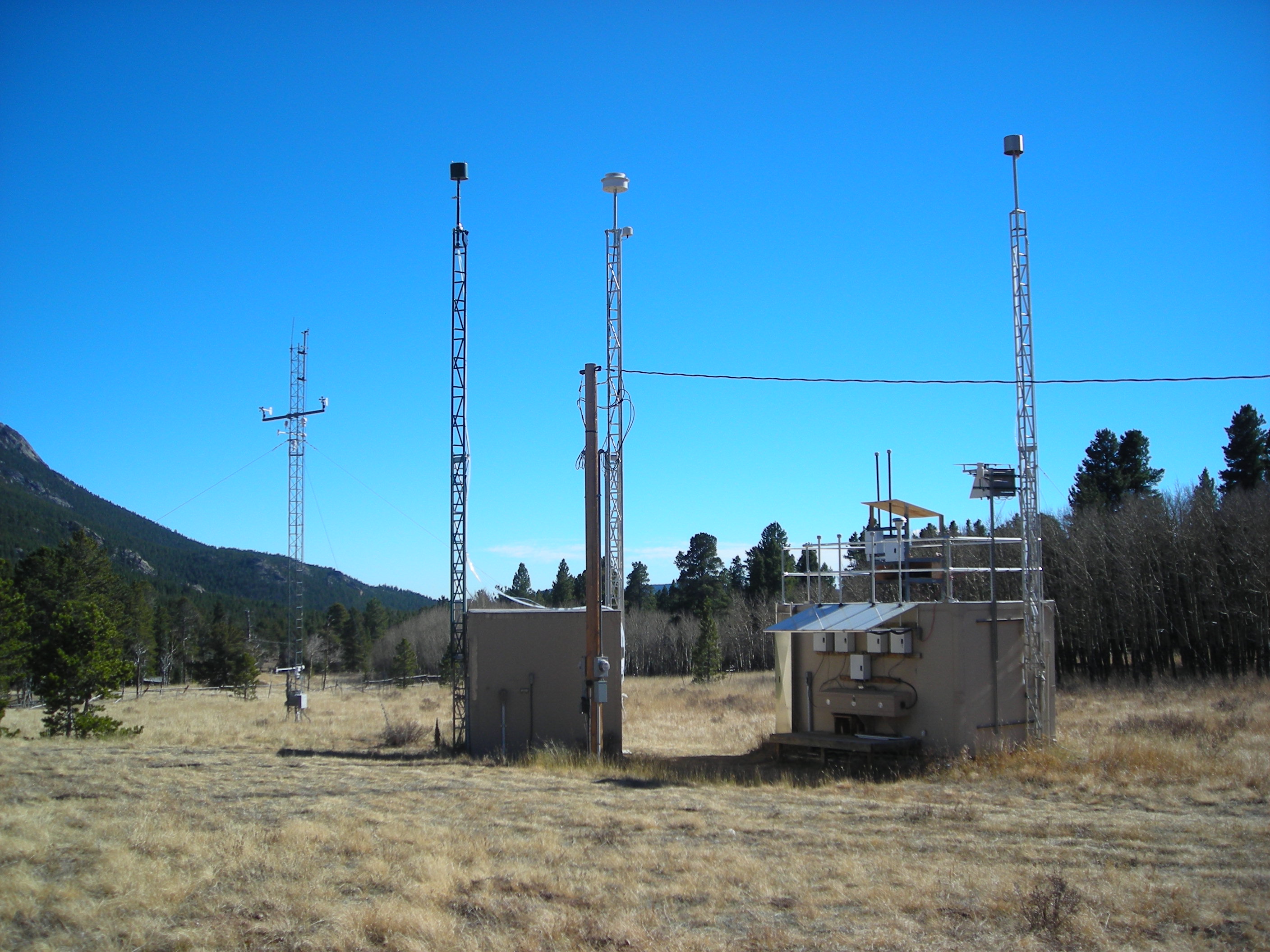
| Site_ID | State | AMon** | Single ADS (NHx only)*** | Dual ADS*** | Super SASS MPPD*** | Super SASS Ion Module*** | CASTNET filterpack |
|---|---|---|---|---|---|---|---|
| ARE128 | PA | x | x | x | x | x | |
| CHE185 | OK | x | x | x | x | x | |
| CTH110 | NY | x | x | x | |||
| PAL190 | TX | x | x | x | |||
| ROM206* | CO | x | x | x | x | x |
* AMoN installed prior to sampling period #5 at ROM206.
** Run in triplicate.
*** Run in duplicate.
Preliminary results show a good comparison between the ADS and AMoN samplers. Comparisons between the MPPDs and the ADS are variable, but this may be a result of invalid flow at the Rocky Mountain NP (ROM206/406) site. Updates will be provided here and the final results will be published in peer-reviewed journal articles.
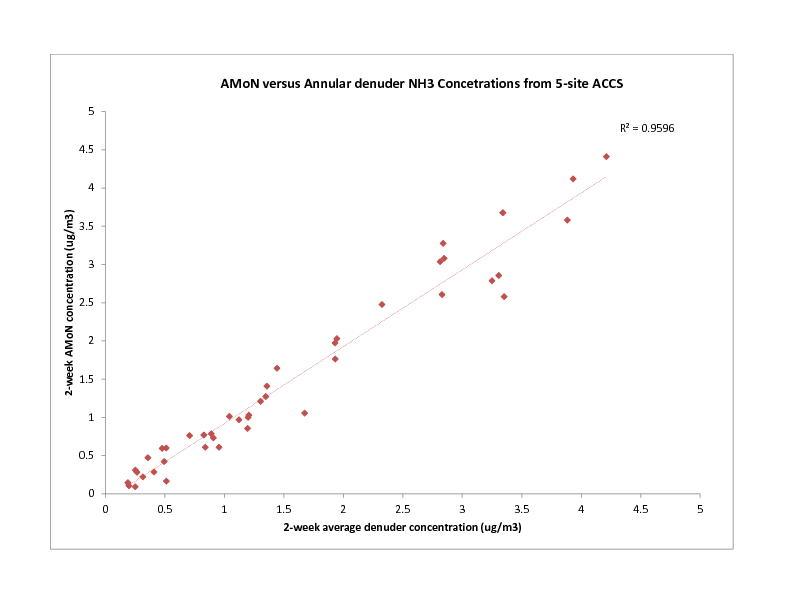
AmeriFlux Deposition Study
Update: October 2011
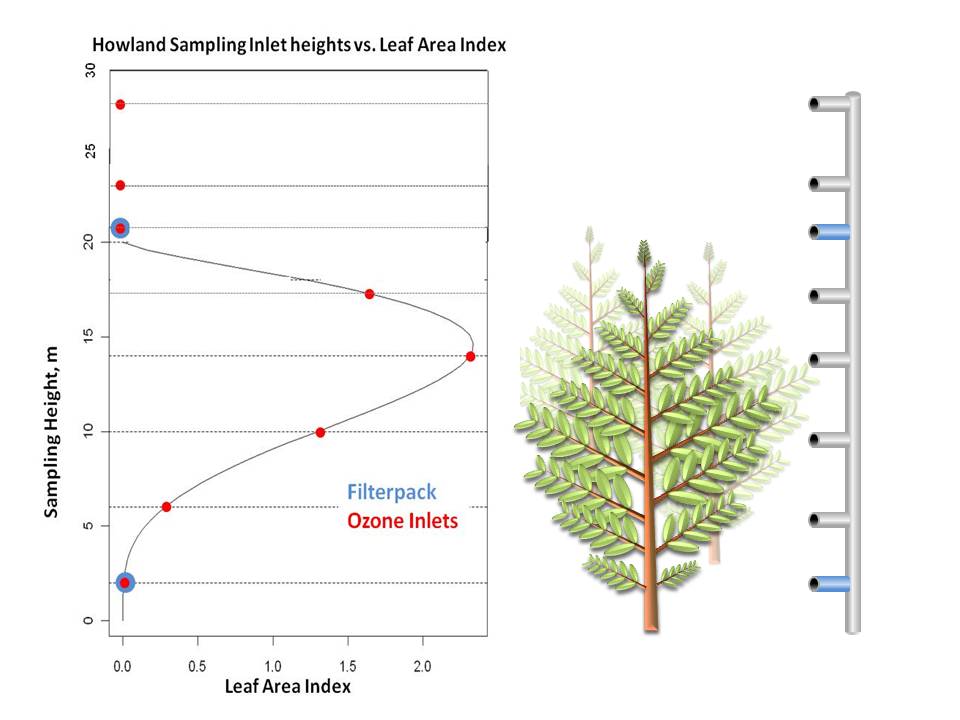
CASTNET will be conducting a direct deposition study at the Howland, ME, AmeriFlux site. The study includes two filterpacks installed above and below the forest canopy at sampling heights of 20.5 and 2 m, respectively, and a multi-stage, solenoid-switch ozone sampling system with inlets at eight different heights: 28, 23.5, 20.5 (just above canopy), 17 (just below canopy), 14.5, 10, 6, and 2 m. The heights were chosen based on the vegetation in the area, represented by Leaf Air Index (LAI), and are represented in the figure below.
The objective of the study is to monitor differences at various heights presumably due to dry deposition on an hourly
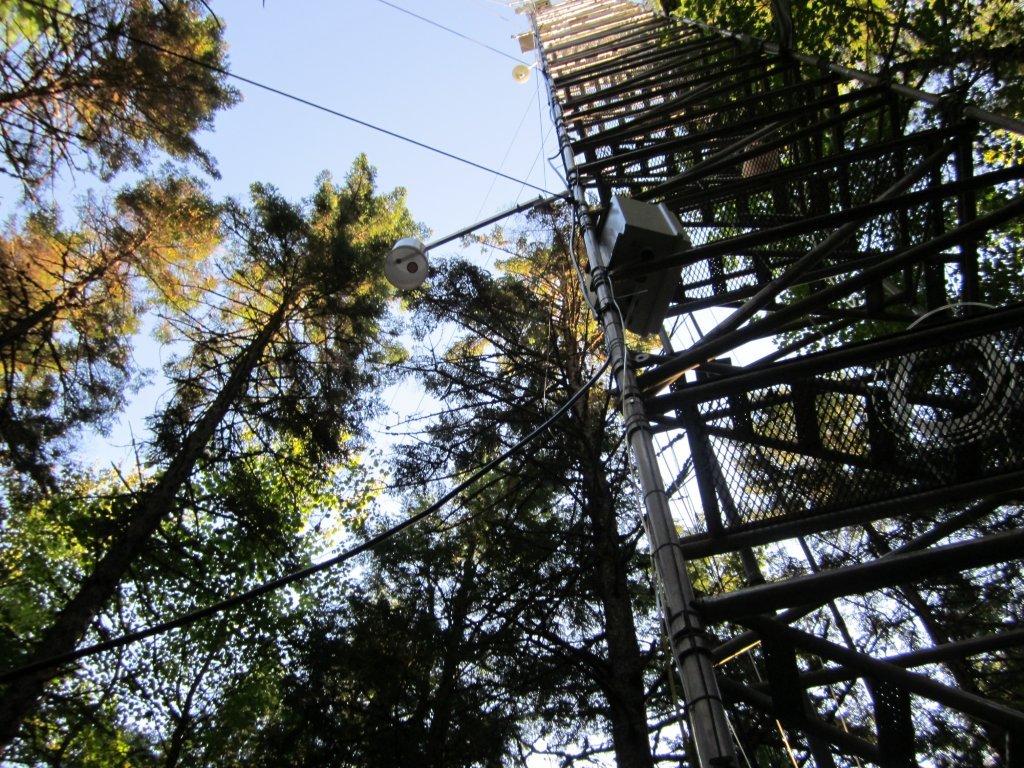
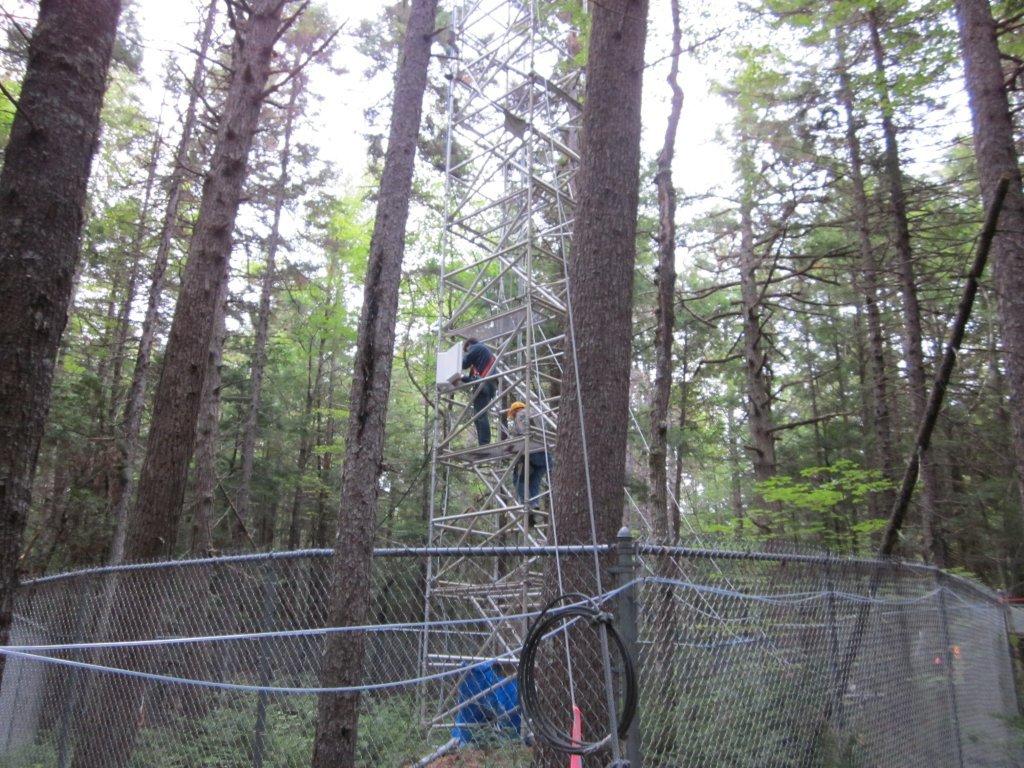
Differences in ozone concentrations will be calculated at the different inlet heights to estimate the deposition flux, above and below the canopy. In addition, CASTNET filterpacks will be deployed on the normal Tuesday - Tuesday CASTNET schedule.
